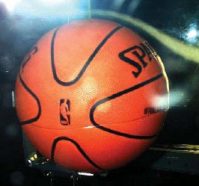A New Basketball Gets Slick
Sweat seems to make a new basketball for professional players more slippery.
By Emily Sohn
Basketball players need more than strength, speed, and skills to be on top of their game. Technology, too, can make the difference between a slam dunk and a stolen ball.
Now, technology and basketball seem to have collided, and some players are calling foul. At the center of the debate is a new type of ball introduced over the summer by the National Basketball Association. The NBA season began last week.
 |
|
A plastic basketball that’s now the official ball of the National Basketball Association undergoes wind tunnel testing.
|
| M. Sosebee, University of Texas-Arlington |
Basketballs used in NBA games have long had a leather cover. The new balls, however, are covered with a special kind of plastic. Spalding, the company that makes the new balls, insists that thorough tests during development showed that the synthetic covering performs better than leather does.
Experiments by scientists in Texas, however, seem to show otherwise. The researchers suggest that the plastic balls are less bouncy, more likely to bounce off course, and more slippery when moistened with sweat. These early experimental results suggest that this change in ball design could have a big effect on the quality of game play.
To compare friction, or the ball’s ability to stick to surfaces (such as hands), the scientists took measurements as they slid both old and new balls against sheets of silicon. Silicon is similar to the palms of our hands in its degree of stickiness.
When dry, the old leather balls slid more easily than did the new plastic balls. When moistened with just one drop of a sweat-like liquid, however, the plastic balls became a lot more slippery than when they were dry.
Leather balls actually became stickier with sweat. And they absorbed moisture about eight times more quickly than the plastic balls did.
“When the balls are dry, the synthetic ball is easier to grip, and when they’re wet, the leather one is much easier to grip,” says physicist James L. Horwitz of the University of Texas-Arlington.
To keep professional players from dropping the ball, it may be necessary to change and clean balls throughout a game.
Some scientists are urging the NBA to reconsider the switch until scientists finish further testing.
John J. Fontanella, a former college basketball player and now a physicist at the United States Naval Academy in Annapolis, Md., belongs to that group. “The NBA,” he says, “should stick with the leather basketball for another year.”
Update: In December, in response to player complaints, the NBA decided to return to the original leather ball, starting on Jan. 1, 2007.—E. Sohn
Going Deeper:
Weiss, Peter. 2006. Dribble quibble: Experiments find that new basketball gets slick. Science News 170(Nov. 4):292-293. Available at http://www.sciencenews.org/articles/20061104/fob4.asp .
To learn more about the new basketball, go to www.nba.com/news/blackbox_060628.html (National Basketball Association).
To see the results of the experiments at the University of Texas-Arlington, go to www.blogmaverick.com/2006/10/27/nba-balls/ (Mark Cuban).
Science project idea: What factors affect how high a basketball bounces? What factors affect its coefficient of friction? How much does the age or material of a ball affect its performance? In what ways?







